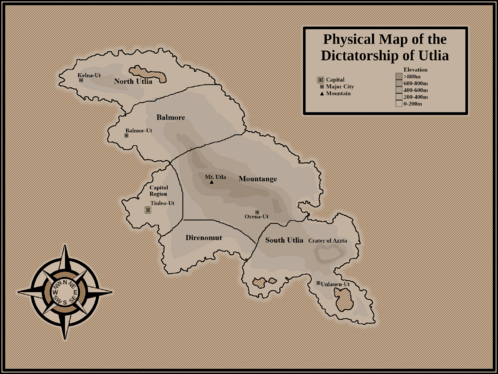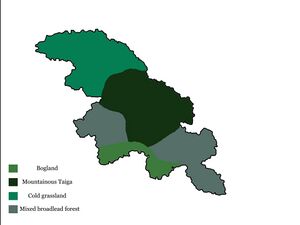Republic of Utlia
The Republic of Utlia is a nation in the Azzta Sea, in-between the island of eee and the Caseic Federation. Utlia is a member of the Eastern Bloc and is currently ruled by Hia El of the UBP. The nation has become renowned for its medical research and large mountains.
Republic of Utlia | |
|---|---|
| Capital | Tinlea-Ut |
| Largest city | Orena-Ut |
| Demonym | Utlian |
| Government | Presidential republic |
• President | Ire Liamia |
| Establishment | |
• Wynlid Liamia founds the Utlian Kingdom | 1095 |
• Monarchy Overthrown | 12-6 6 TT |
| Population | |
• Estimate | 860,000 |
| Currency | Utlian Dolare (UD) |
History

Tribal Era
Before the unification and subsequent kingdoms Utlia was shared by scattered groups of semi-nomadic tribes. The largest of these tribes were the Utans, a group who had settled in the northwestern grasslands. The inner mountain range was the most densely packed with tribal groups on the island. The southern tip of Utlia held very few groups, however these groups became some of the most important as much of Utlian culture comes from this region.
Unification
After settling into regions of Utlia, many of the tribes began to amalgamate into larger groups. In the north the Utans merged with smaller neighbors to the east and controlled the island north of where the Balmor river flows, this group became the Eutan Kingdom. It is unknown when the southern tribes began to merge, according to Tinlea-Ut historian Tmyl Srain, the southern groups may have began the merging process before their northern peers however this claim is heavily disputed within the Utlian Historical Society. The southern groups did merge at some point into the Frish
The Frishs and the Eutans were by far the most prosperous of the proto-kingdoms in Utlia, with many of the smaller groups falling apart. The two groups were very aware of the other one and had a friendly professional relationship. On 4-7 1102 Wynlid Liamia and Shaen eien, the kings of the Eutan Kingdom and the Frish Kingdom respectively, met at a site near the Balmor river and signed a declaration of unification, merging the two into one kingdom, known as Utlia. This moment has long been mainly attributed to Wynlid but in recent years, modern Utlian historians have began to recognize the importance of the Frishens in the agreement.
Modern Era and Post Calming
The last heir of Utlia was King Ywylin, who was overthrown by the RGOU, a revolutionary group led by Yyme Braia and Votan. This is considered the start of the modern era by historians and the Utlian government. The RGOU became the Utlian National Defense Force and Yyme became the first Utlian president, with Votan as Lieutenant President. The Yyme upper cabinet at time time was largely composed of former RGOU members and soldiers the president trusted.
On 7-12-16 PC Yyme Braia fell ill and died to Common Mor-Virus. After a lengthy deliberation by the Utlian Nomination Committee, Hia El was chosen as his replacement.
in 24 PC the nation held its first federal democratic election with Ire Liamia, representing the UBP beating Vyma Arnea of the TPU with 55% of the percent.
in 25 PC, as a response to a suspected terror attack by the YDF in Ronatana, Ire Liamia declared war on the YDF after speaking with the Upper Cabinet
TPU Split
On 5-3 25 PC Ire Liamia passed a bill giving the Merriyem citizens of Utlia equal rights and the ability to run in politics, in response the opposition faction of Utlia in the Lower Cabinet, the TPU introduced a bill to force Ire Liamia and all his Upper Cabinet members to resign from both their positions and public appearances. The bill was signed by all 14 TPU members and 10 UBP members of the LC. Ire Liamia and the Upper Cabinet refused the bill, despite the majority of LC approval, in retribution the signatories sent Ire and other prominent members of the UC pamphlets detailing what TPU Lower Cabinet leader Byrn Lowsieyyme considers the crimes of the UBP, mainly the equal rights of Merriyem Utlians. Byrn was then fired from her position in late 25 PC for threatening lives with her pamphlets. After Byrns removal, members of the TPU walked out of the lower cabinet during a session in protest. Members who did not join the walkout then arranged a meeting with President Liamia where they proposed the splitting of the TPU into different factions, to allow for a more specific ideological party. The UAG was then formed by the group after they were allowed a faction formation grant.
Culture
Utlian culture is heavily based off food, more specifically crustaceans like crab or lobster. In Utlia, many holidays base around feasting and gift giving to family and friends. Fishing and Ranching have been important parts of both economy and recreation in Utlian history.
Religion
Utlias main religion is based around the god known as Azzta, who takes the form of a massive Snow Crab. Azzta birthed Utlia as his holy land, where his people would prosper. the religion gained popularity when the first prophet found Azztas Crater, a hole caused by Azztas protection of Utlia from a meteor. in the hole the prophet found a mass of smoking dead crabs. The man then went to his home and preached the word of this miracle. Azztanism has 2 historic denominations, the Eutan and Frishen versions.
While a minority, other religions do exist in Utlia, most notably the Merriyem. The Merriyem are a group living in the eastern mountains of Mountange who believe that there are deities for all natural things. Merriyems were originally allowed to practice their religion in Mountange due to their worship of idols in their religion, a major shared trait with both branches of Azztanism.
Geography

Utlia is a cold, mountain heavy land with dense forests in the majority of the island but some plains in the north section.
Provinces
North Utlia, the northmost province is where a majority of farming and ranching happens on Utlia. North Utlia also houses Kelna-Ut a major city in the north. Balmore is the oldest province in Utlia and features the north edge of the Mount Utlia range. Western Balmore is also where Balmor-Ut, a historic city stands. Southwest of Balmore is The capital region, the youngest and smallest province in Utlia. The capital region is mainly the urban area around Tinlea-Ut. East is Mountange with the largest city in Utlia, Orena-Ut. West of Mountange is Direnomut, the least populated province with no major city. Finally is South Utlia, a region full of lakes,rivers and religious sites as well as Unlaunen-Ut.
East Ocean Territory
After the discovery of the East Ocean archipelago, Utlia sent ships to begin colonizing islands in the region, this land became known as the Utlian East Ocean Territory, which was officially incorporated into the republics provinces in 3-5 25PC.
Wildlife
Utlia has a diverse range of wildlife with birds being the most abundant. The north shores of the island have the highest density of grylbos, a large tusked mammal with long whiskers native to the snowy coasts of Mountange province. The grylbos are considered sacred food by both Azztans and Merriyem members.
Government
Utlia is a Democratic Republic, where citizens elect both local and federal leaders, including the lower cabinet. Citizens do not vote in the Upper cabinet as that is the presidents personal advisor team.
The Federal Cabinet is a group of people personally appointed by the president who represent sectors of the government such as the military, agriculture or education.
Utlia has many Political Parties, the main 2 being the UBP and TPU.
Economy
Utlias economy is heavily based around fishing and ranching, the main producer of animal products being Kelna-Ut and the main producer of fishing goods is Balmore-Ut. Coal has become a major player in the Utlian economy, the majority of which comes out of Unlaunen-Ut in south Utlia.
Medicine
Utlia has a high concentration of medical workers and researchers, making it one of the major pillars of the Utlian economy. The high amounts of research make medicine much more advanced and funded than other major systems like military or public works.